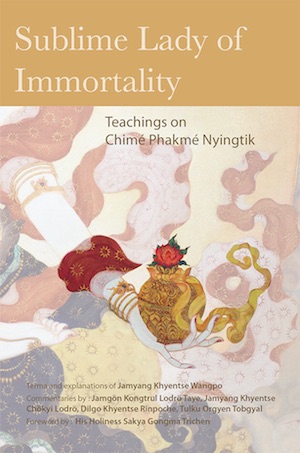New Delhi, 11 January 2015
I was asked to comment on Kyabjé Dudjom Rinpoche’s Short Practice of Sengé Dongma. It is a practice for averting obstacles associated with Sengé Dongma. I don’t have anything special to say about this particular practice.
In general, the way you perform the various types of practices for averting obstacles are similar. On this basis, you visualize yourself instantaneously as an enormous Sengé Dongma. Visualize the syllable Jo at her heart. This syllable, the life force of Sengé Dongma, is surrounded by the mantra ah ka sa ma ra tza sha da ra sa ma ra ya phat. In terms of the meaning, there is nothing to explain, since these are simply syllables. It is a Ngakgö.[1]Ngakgö is a mantra in which the syllables have no particular meaning. The mantra itself is power. (Sogyal Rinpoche)
What is this mantra? In ancient India, some tirthikas were throwing curses and spells on a Buddhist pandita. The pandita invoked the wisdom dakinis and asked how to avert the curses. From the heart of all the dakinis appeared the ‘Inestimable Great Golden Casket’. When it opened, the mantra ah ka sa ma ra tza sha da ra sa ma ra ya phat emerged.
The dakinis said, “This mantra is a mantra to be worn.” What is meant by ‘a mantra to be worn’? It means that all you have to do is wear the mantra and all negativity, curses and spells will be averted. The individual syllables of the mantra have no specific meaning. You wear the mantra around your neck.
The pandita did not understand the dakinis’ advice. When the tirthikas put an incredibly powerful curse on him, he prayed to the dakinis. The dakinis gave him the mantra and told him, “You don’t need to recite or do anything else. All you need to do is wear it and think of it.” In spite of this advice, the pandita remained extremely frightened by the curses, and he spent an entire week reciting the mantra. All the tirthikas fainted, were driven insane or died, and so they all disappeared without any more trouble. Such is the power of this mantra.
When the dakinis returned, they asked the pandita to hand back the mantra: “You totally messed it up! We told you to put it around your neck and not to recite it, but you’ve been reciting it around the clock! The power of this mantra is so great that you have destroyed the entire company of tirthikas. You made a really big mistake when you started reciting this mantra.”
After that, the pandita hid the mantra as a terma. Later, Guru Rinpoche revealed it when he manifested in the form of Guru Sengé Dradrok[2]Guru Sengé Dradok, ‘The Lion’s Roar’, is one of the Eight Manifestations of Guru Rinpoche. According to page 30 of A Great Treasure of Blessings (London: The Tertön Sogyal Trust, 2004):
Guru Rinpoche challenged and defeated five hundred upholders of wrong views (tirthikas) in debate at Bodhgaya. He reversed their magic with the aid of a wrathful mantra given him by the lion-faced dakini Marajita.
He is known as Sengé Dradok, 'The Lion's Roar'., and then read it and transmitted it. Later on, he hid it again. There are many different accounts concerning the history of this mantra.
When revealing the terma, Guru Rinpoche also revealed many sadhanas of Sengé Dongma, and he added the mantra to these practices. At the heart is the syllable Jo, surrounded by the syllables of the mantra mala, ah ka sa ma ra tza sha da ra sa ma ra ya phat, arranged clockwise. Shimmering and turning counter-clockwise, the mantra eliminates all obstacles to the Dharma, as if they were being shredded with a razor blade. So you need to recite the mantra when you do these sadhana practices.
Looking at the sadhana, it says that you appear as Sengé Dongma, the self-radiance of the mantra, instantaneously. At the exact moment you begin to recite the mantra, based on its power, all adversaries, enemies, evil influences, gods, demons and so on completely dissolve into the hands of Sengé Dongma. The sun of the right hand and the moon of the left hand are clapped together. In some other practices, the right hand is the earth, and the left the sky; in such cases it would be the sky and the earth clapping together.
Whatever the case may be, visualize the sun and the moon (or the sky and the earth) clearly. Clap your hands as if you were crashing cymbals together. Through this collision of the sun and moon all enemies, negativity, obstacles, noxious spirits, curses, spells and all gods and demons are crushed into dust and disappear, so that not even their names remain.
This is the way to direct your practice. I didn’t receive specific instruction on Kyabjé Dudjom Rinpoche’s practice, but this is the way Sengé Dongma is practised in general.
When you practise Sengé Dongma daily, direct it as I have explained. You don’t need to do anything else.
As I’ve already explained, the mantra of Sengé Dongma is a mantra to wear. In Jamyang Khyentse Chökyi Lodrö’s tent, there was a piece of paper with the handwriting of Shechen Gyaltsap Rinpoche on it. When I looked at it, I saw that it was the mantra ah ka sa ma ra tza sha da ra sa ma ra ya phat. It was written in black ink on ordinary paper. Also, Kyabjé Dilgo Khyentse Rinpoche wrote some copies of the mantra in gold and tied them onto strings; everybody was wearing them around their necks.
Translated by Gyurmé Avertin
Edited by Jeremy Tattersall

